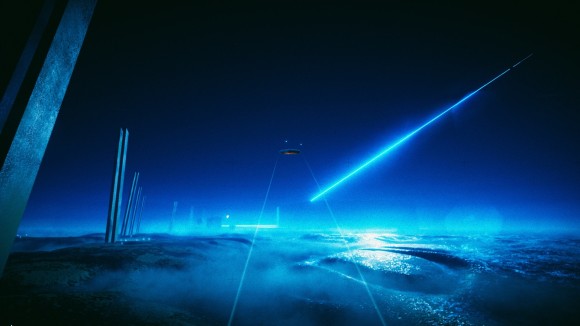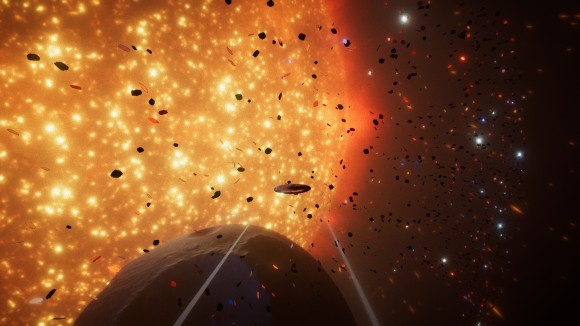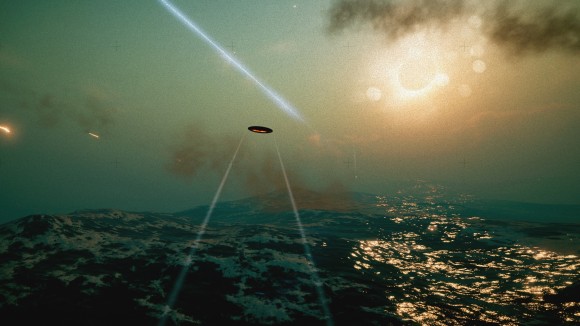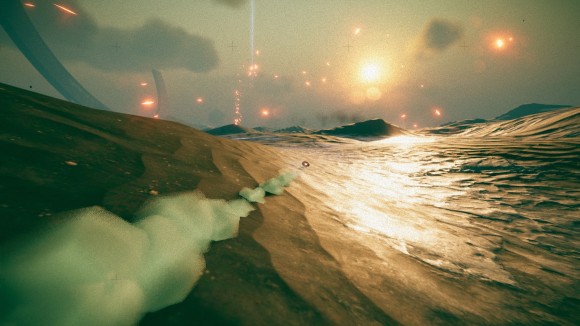At the end of last week’s review of Treasures of the Aegean I talked a bit about how impressed I was with its clarity of vision. This is something that I always value in a game, but also something which happened to be particularly on my mind at the time because I’d just finished playing Exo One, which handily demonstrates how confused your game can end up feeling when you don’t have this.
What is Exo One? It’s a good question, and one which I’m not sure the mostly-solo developer behind it could fully answer. I am certainly struggling to answer it in a satisfactory way. I want to describe it as the flying equivalent of a walking simulator, a game about peacefully skimming your alien glider across extraterrestrial oceans and through the cotton-candy clouds of gas giants. Except it’s not that, not really, because it has too many actual mechanics to devote your full and undivided attention to the visuals. It could also be described as a weird take on marble run, where you crash your ship down a slope to pick up speed and then turn on glide mode just as you hit the nadir of the trough to gracefully fly back up the other side and into the sky, and that you’re supposed to acquire enough technical familiarity with this process to be able to seamlessly chain these velocity-boosting runs together to reach each level’s ultimate goal. But Exo One isn’t really about that either, because it puts far too many barriers in your way for this to feel like it’s the thing that Exo One is about. There’s nothing stopping it being both of these things at once, of course, but if that were the intention then I would expect each element of Exo One to complement and enhance one another instead of repeatedly getting in each other’s way as they do here.
Exo One does start promisingly, at least; as the first level is supposed to teach you the basics of the game, it also happens to be the one that plays to the game’s strengths the most. The idea behind Exo One is that aliens have transmitted to Earth plans for a probe which humanity can use to explore nearby stars via a convenient system of transport monoliths located on the planets that you visit. Each planet is one level, and consists of you rolling/flying your probe spaceship from your landing spot towards the giant column of light representing the transport monolith to the next planet. The probe looks a bit like the alien ship from Flight of the Navigator, which is the only reason I downloaded Exo One at all, but what it actually is is a cross between a marble and a frisbee. Hold down the right trigger on your controller and it’ll engage its gravity drive, increasing its mass, turning into a ball and plummeting towards the ground at frightening speed. Hold down the left one and it’ll engage glide mode, turning into an oval disc much like a classic flying saucer and skimming through the air — but as the phrase “glide mode” implies, it has no source of motive propulsion. All it has is whatever leftover momentum you built up by diving/falling with the gravity drive.
So the basic idea here is that you look for a nice inverted crescent slope, ideally one that looks exactly like a classic skateboarder’s half-pipe. You position the ship just above one lip of the slope, and then turn on gravity drive; this sends you hurtling down the slope at frightening speed, but you need to turn off gravity drive and switch to glide mode before you get to the bottom and start your ascent up the other side, because the gravity drive hugely increases the mass of your ship and if you leave it on just a split-second too long it’ll bleed off all of that tasty momentum and roll back down towards the bottom of the slope. If you’re in glide mode, on the other hand, you’ll shoot up into the sky and fly towards your destination — at least until you’ve lost enough velocity (these extraterrestrial worlds must all have extremely thick atmospheres to produce this much drag effect) that you need to repeat the process.
That’s about all there is to Exo One’s mechanics. Unfortunately the seeming simplicity of Exo One’s gameplay is very much at odds with the other part of the game — the sightseeing part. Exo One’s planets are all quite striking environments — ocean planets, lava planets, asteroids, gas giants and more besides — and unfailingly pretty, but unfortunately it feels the need to have these environments manifest themselves in terms of gameplay as well as in look and feel. This means that every single planet past the first one has some kind of additional gimmick beyond the gravity/glide modes, which ordinarily I would applaud and is the way this kind of game should be built, but in Exo One’s case I think nearly every single gameplay variation it introduces is totally at odds with the graceful simplicity of diving and then gliding. On one planet you’re travelling through a forest and always going uphill, with precious few downward slopes to give you a speed boost. On another your glide mode is outright disabled and you’re forced to just roll around with some strong winds that compensate for the various slopes all seemingly being oriented away from your objective; the idea here is that you’re supposed to find some way of gaining enough height to get up into the cloud cover where lightning will recharge your ship and reactivate glide mode, but it took me about ten minutes of awkward rolling to figure out how to make this happen. A third level isn’t a planet at all, but instead a series of asteroids floating above a star; this is possibly the most striking level in the game but also the most frustrating, as the game engine isn’t really set up to deal with moving from asteroid to asteroid and constantly fights you, making it a real challenge to figure out which way your camera is pointing1.
The only one of these gimmicks that I actually liked — the only one that both seemed set up to not make my life needlessly awkward, and which complimented the actual gameplay in form as well as function — were the two water planets. Here you can activate gravity drive and sink through the ocean depths until you hit the conveniently curved ocean floor which sends you towards the surface again, but being in glide mode seems to make your ship unreasonably buoyant and you can’t cover much (or any) horizontal distance while you’re underwater. But there is a way around this; instead of activating the gravity drive, you can instead stay in glide mode and try and give your approach to the ocean’s surface a sufficiently shallow angle. If you do it just right, your disc-shaped ship will skip from wave to wave like a pebble being skimmed across the surface of a pond. This was well-themed and a rare example of an environmental mechanic that was set up to actually help me on my way instead of acting as a point of frustration.
And then behind all of these gimmicks and environmental obstacles are the restrictions built into the ship itself. As stated, it can’t fly in glide mode indefinitely and will eventually run out of whatever alien go-juice it’s running on and fall back towards the ground, but how much go-juice you have is actually completely divorced from the amount of momentum. You’ll lose that too, of course — the ship will slow — but you can get it back by doing a quick dive and trading altitude for speed, as you would expect from a game about flying. However, the total amount of time you can spend in the air is solely governed by a strict timer that seems far, far too short. Exo One surfaces this timer to you by giving the bottom half of your ship a glow that gradually fades while you’re in the air, which I did think was a nicely minimalistic way of doing it without having to bring in any additional UI elements; when the glow is completely gone, though, your ship can’t stay in glide mode no matter how fast or how high you are and you’ll revert into ball mode and begin a slow, sad trip groundwards. Being in contact with the ground recharges the glide mode timer and lets you fly again, and it’s this latter element that reminded me uncomfortably of another game that had a great flight mechanic and then put as many barriers in the way of actually using it as it could possibly come up with: the late, not at all lamented Anthem. And believe me, that is not a comparison Exo One wants to be inviting upon itself.
This is the question that I’m having trouble answering, then: when you have a game that seems so ready-made to be a contemplative, abstract jaunt across the galaxy with a neat mobility mechanic, why throw all of these complications into the mix? It seems like such a pointless own goal; I felt like Exo One was fighting against me almost the entire time I was playing it, and that’s a shame because I really did like the look and feel of the thing. The visuals on some planets are astonishing and there is one later level which just cuts the bullshit and focuses on flying up a series of gigantic artificial platforms using a series of booster rings that recharge glide mode every time you go through one; this was unusual because I had an obvious goal and there were no restrictions on my movement for once, and it was very enjoyable. On the other hand the final level is a voyage through the outer levels of a gas giant which similarly has few restrictions on where you can go, but the lack of obstacles and interesting scenery — it’s hard to put memorable features inside the atmosphere of a gas giant — meant that once the initial rush of flying through the clouds had subsided I was just trying to get to the objective in as short a time as possible. This proves that Exo One does need some crunch, to be rather more than just flying from the start to the end of a level while gawping at things, but said crunch could have been provided quite adequately by basic tried-and-true mechanisms (such as the booster rings) rather than a finicky flight system that’s crippled on nearly every single level past the first one.
Because in the end, despite being a very short game that clocks in at around two and a half hours long, my overwhelming impression of Exo One is one of frustration rather than pleasure. I was frustrated at the waste of a good, simple idea; frustrated that the two halves of the game meshed together so badly; and frustrated at the constant intrusion of the plot, which is a vague mess of nobody-cares that nevertheless feels the need to blast flashing subliminal images of the planet Jupiter at you2 while you’re in the middle of trying to perform some delicate maneuver before your flight time runs out. It’s a very pretty game (I’ve not seen better skyboxes outside of a Bungie game), and the core design and feel of the flight is good, but everything else about Exo One works at cross-purposes with things that it does well. If I’d bought it on Steam I’d probably have refunded it before finishing it in spite of it being shorter than most modern movies3; as it’s on Game Pass I pushed through to the end, but I can’t say I found the experience all that worthwhile.
- I would also question exactly why glide mode continues to lose velocity in an environment with no atmosphere. ↩
- These flashing images aren’t just aggressive and obnoxious, they actually require the game to open with an epilepsy warning when you boot it, which is perhaps a sign that this wasn’t really thought through. At all. ↩
- Which have slowly bloated over the last three decades from typically being just over an hour and a half to nearly twice that long. ↩





I’m epileptic, can confirm this game needs the warning. Usually i can just ignore them but not here. I had to turn it off on the second level. Only other thing to have sent me over the edge was a 3d game boy.